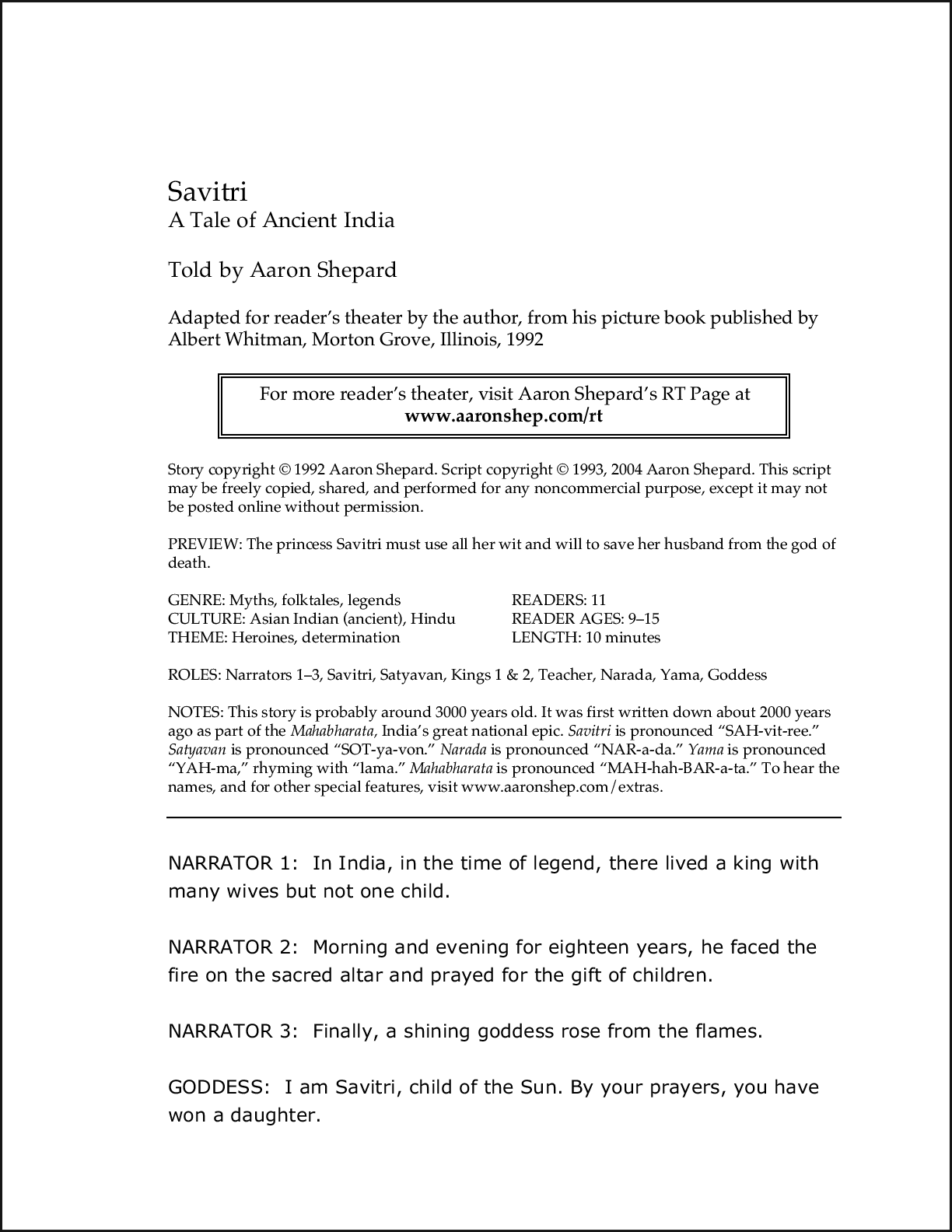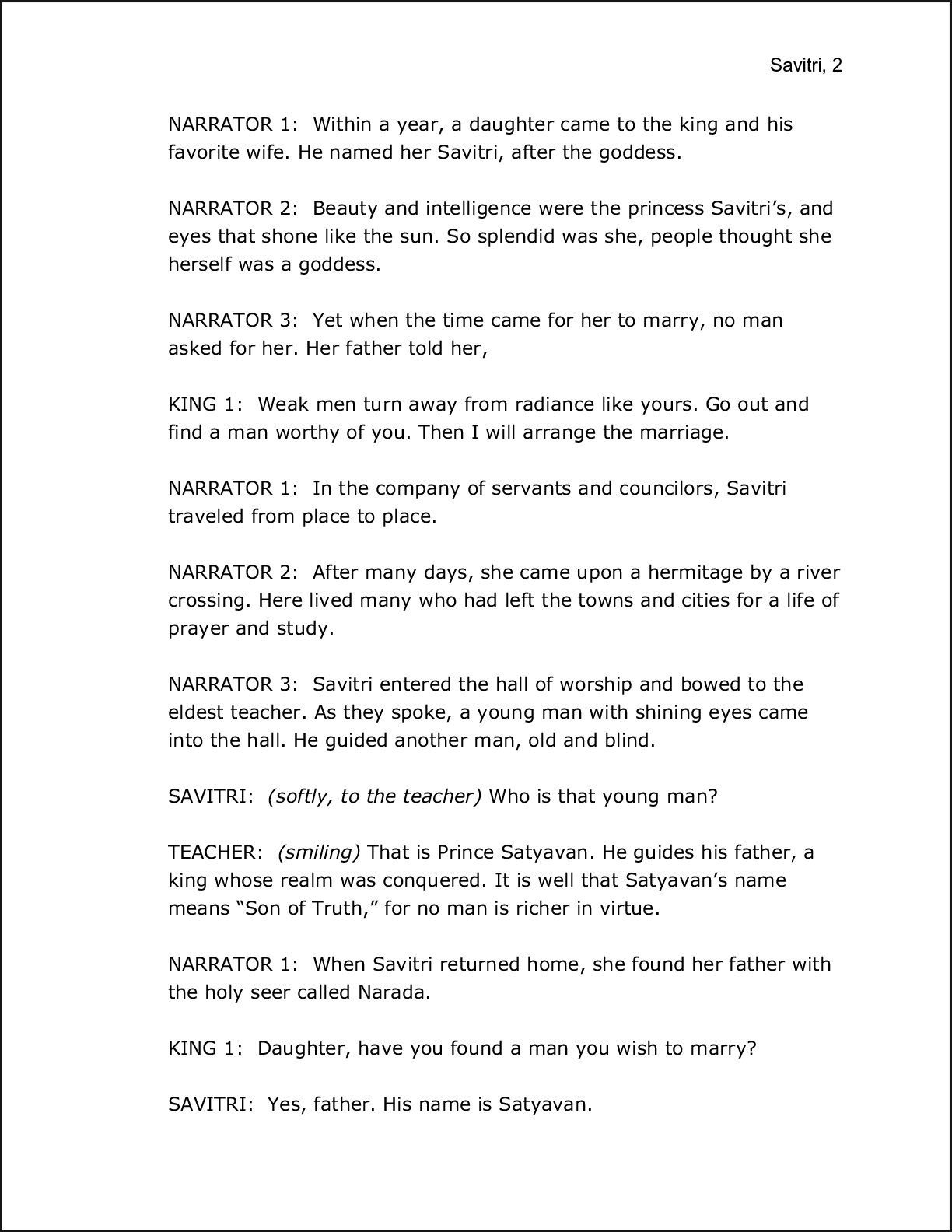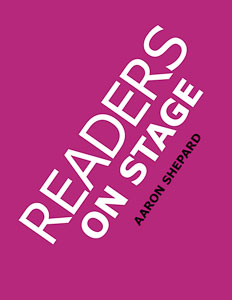Almost any story can be scripted for reader’s theater, but some are easier and work better than others. In general, look for stories that are simple and lively, with lots of dialog or action, and with not too many scenes or characters.
Script Roles
First study your chosen story to identify the roles. There are two basic types: Narrators tell the story. Characters are in the story. (In first‑person stories, of course, the narrator is also a character.) To help your readers understand the types, you can explain that character parts appear in the story inside quotation marks, while narrator parts appear outside.
If the group you’re working with is small, a story may have more roles than you have readers. In some such cases, a story may simply not be practical for you. But there are often ways to adjust:
Assign more than one role each to individual readers. But make sure a reader isn’t onstage with more than one role at a time!
“Cut” a character, or combine it with another. Speeches of one character can often be added to those of another.
Use character narration in place of a separate narrator. With this approach, characters read the narrator parts that refer to them or that reflect their point of view. This takes some getting used to, though, and often feels clumsy and unnatural.
Instead of too few readers, you may have more than you need. Here are some ways to involve more of them:
Use two or more narrators. This is usually a good idea anyway for young readers. For tips on splitting narration, see the “Narration” section below.
Split characters into two or more. A character can sometimes be converted into a set of characters, with the speaking parts divided among them.
Assign silent characters. Often stories have minor characters without speaking parts. If your directing style includes stage movement, you can assign these roles to surplus readers. You might also add speeches for them. Crowd scenes can always use extra readers.
Cuts and Changes
Feel free to make cuts and changes in the story that will make your script livelier, simpler to understand, or easier to perform. But be sure to read through and check whether everything in the story still makes sense.
Some authorities on reader’s theater will object to even the most minor changes in the author’s work. But the author was not writing for performance. If you refrain from making appropriate changes, the author’s work may not appear in its best light.
Here are some things you may want to “cut”:
Tag lines. These are the lines that tell us “he said” or “she said.” In performance, these seldom do more than break up the flow of the story and trip up the readers. But leave in the ones that give extra information the audience must hear. Also leave in ones that an author has used to build rhythm.
Long descriptions. Many stories include long sections of narration that slow the action. These can often be shortened or even removed.
Minor characters or scenes. Cutting these can simplify the stage action or adjust for a small number of readers. Often, important dialog or information can be shifted to another character or scene.
Here are other areas where you might make changes:
Character splitting or combining. As mentioned earlier, you can combine two or more similar characters into one, or split one into two or more.
Additional speeches. Some story characters may have no lines, or may be onstage for a long time before they speak. In these cases, you may want to invent brief speeches for them. Also, if the narration tells about what a character said, you might convert this into a speech of the character.
Stage directions. You can often make the script smoother by converting parts of the narration to stage directions for the characters.
Difficult or obscure language. Though readers should be encouraged to read “up” from their level, some scripts will be much easier to follow—for both readers and audience—if you now and then substitute a simpler word, or split a sentence in two. With foreign stories, you may want to “translate” unfamiliar terms.
Sexist or demeaning language. Often this can be changed unobtrusively. If not, the story may not be appropriate for young people.
Aids to reading. You can underline or italicize words that should be stressed, add commas to delineate phrasing, or insert stage directions to indicate the feeling behind speeches.
Narration
In scripts for younger readers, it’s usually best to have two or more narrators. Besides creating extra roles, it spreads the responsibility for this very important function. It also helps retain audience interest during long narrative passages.
Splitting the narration can be done as simply or as artfully as you like. The way that is best often depends on how the story was written. Here are some possibilities:
With two or more narrators, assign them successive paragraphs or half‑paragraphs. It’s best to adjust paragraph splits so Narrator 1 begins each new scene. This limits the reassignments made necessary by later script changes, such as adding or removing a single narrator speech. To make things more lively, divide your narrators between the ends of the stage, with assigned speeches alternating between the ends.
With two or more narrators, “bounce” back and forth among them in a way that reflects an author’s strong rhythmic structure. This can mean trading off on sentences, or even on phrases.
Switch to a different narrator with each new scene.
“Sandwich” the dialog. One narrator speaks both before and after a section of character dialog. Then the next narrator does the same.
Assign a narrator to each character. Each narrator reads all the lines that refer to their assigned character or that reflect their character’s point of view.
Divide narration between the narrators and the characters themselves. This form of character narration works best if the characters don’t actually mention themselves.
In general, the younger the readers, the more narrators you want. Most of my own scripts now get four narrators, and some get as many as eight.
Script Format
Scripts should be neat and easy to read. Readers are supposed to look up often from their scripts, and they will have trouble finding their place again if the page is too crammed with text—or if the text is too spread out.
Sample Script Pages


Sample script pages (PDF, 2 pages)
Here’s the format I recommend:
Large, readable type. I suggest using 12‑point Verdana, while 12‑point Georgia is also good. Both fonts, designed for reading on the Web, are standard on both Windows PCs and Macs. For a smaller typeface like Times, Helvetica, or Arial, 14‑point is a better size. Supporting info at the start of the script can be in smaller type to save space.
Linespacing set at 1.5 (halfway between single and double spacing).
Left margin, 1.5 inches. (This is extra-wide to allow for binding and to let readers add stage directions.) Right margin, 1 inch. Top margin, 1 inch, including the header. Bottom margin, .5 inch or more.
A header at top right with one or two key words from the script title, plus the page number.
Block paragraph format—no indent, either regular or hanging. A blank line or “space after” following each speech.
Lines aligned left—not “justified” but with the right margin kept uneven.
No splitting of speeches—or at least of paragraphs—between one page and the next. The direct way to avoid it is to insert a page break above any speech that would be split. A better way is to format your paragraphs to “keep lines together” or to “protect” them against splitting, individually or as a paragraph style.
Clearly distinguishable “role tags.” These are the identifiers that tell who says what. Put them in all caps or bold with at least two spaces after, to set them off from other text.
Clearly distinguishable stage directions. I suggest setting them in parentheses and italics.
Scene dividers. If there’s a sharp break between two scenes instead of a smooth transition, use a row of asterisks or such to signal a pause in reading.
End marker. Use a line or other marking of your choice to make clear when there are no more pages to read.
Team Scripting
Children working in teams are easily capable of scripting short, simple stories. Here is one approach:
First explain briefly about identifying the types of roles, adjusting for more or fewer readers, and possible cutting. Divide the readers into teams of about four. Assign a one‑page story to each team, with each member receiving a copy. (Fables work well.)
The team members read through their story, identify the roles, and divide the roles among themselves. Then they decide who will read what. Each reader underlines his or her own speaking parts—in pencil, to allow changes—and also crosses out anything the whole team agrees to cut. If you wish, these individual copies can later be compiled into a master script in standard format.
Normally, young readers can have a one‑page story ready for tryout in about a quarter hour, with practically no adult help. With adult help, it can take much longer.
